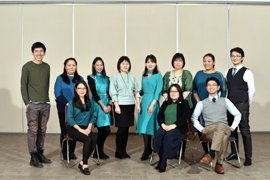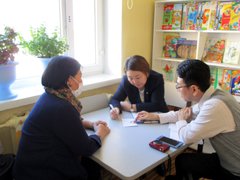Mongolia-Japan Center for Human Resources Development, Japanese-Language Section: “Mongolia! I’m Back!”
Mongolia-Japan Center for Human Resources Development
MITSUMOTO Tomoya
“Mongolia! I’m Back!”
This is my first dispatch to Mongolia since I spent two years here from 2002 as a Japan Overseas Cooperation Volunteer. At that time, horses and cows nonchalantly grazed on the grass in the vicinity of the airport. Now, however, groves of large department stores, new apartment buildings and splendid private schools stand there. I was somewhat put off by the scale of the development and the feeling that everything had changed, but I launched into my activities by going around classes, listening to what the teachers had to say, and updating my knowledge of Japanese-language education in Mongolia.
Mongolia-Japan Center for Human Resources Development’s “Japanese-Language Course”

The Japanese-language section’s
Japanese-language course instructors
The Mongolia-Japan Center for Human Resources Development (hereinafter the “Center”) where I am dispatched was opened in 2002 through the cooperation of the Japan International Cooperation Agency (JICA), Ministry of Education and Science of Mongolia and the National University of Mongolia, with the goal of training personnel to contribute to promoting Mongolia’s transformation into a market economy, and encouraging mutual understanding between Mongolia and Japan. The Japan Foundation (hereinafter “JF”) has also been dispatching Japanese-Language Specialists from 2002 until the present day, and has been jointly running the “Japanese-language course” since 2012. The Japanese-language course makes it possible to study the Japanese language from the Starter level to Intermediate level. A textbook known as “Marugoto: Japanese Language and Culture,” which is based on the JF Standard for Japanese-Language Education (hereinafter the “JF Standard”), is employed as the main text in the course. This is the seventh year since the course began, and there is a full lineup of lesson plans, teaching material and supplementary teaching material in place, but the instructors in the Japanese-language section nevertheless strive day after day to develop further initiatives. This reflects the attitude that underpins the Center’s work – namely, “let’s conceive and propose things ourselves, and implement them.”
For example, in a recent Elementary course, ideas that are being put into practice include introducing “Tadoku reading” during the waiting time prior to class (using The Japan Foundation Japanese-Language Institute, Kansai’s “KC Yomu Yomu” series and a graded extensive reading library); and having the students reutilize composition sheets they had written as homework by using the content of those compositions to create self-introduction booklets known as “My-ny(my -tiny) Books”), which they then show to each other. As a Japanese-Language Specialist, I am also required to promote further understanding of the JF Standard for Japanese-Language Education while questioning the meaning underlying instructors’ ideas and whether better methods exist, as well as prepare the environment and stimulation needed to encourage new ideas to be hatched. I hold training once every two weeks for the instructors, who have strong Japanese-language skills and a strong sense of professionalism. Every day I enjoy racking my brains about what should I present at that training, and how I should approach it.
“Cooperation” for Individuals Studying and Teaching the Japanese Language in Mongolia

Traveling consultation
The Japanese-language section’s slogan is written on a board in the staffroom: “Everything is for the people who study and teach Japanese in Mongolia.”
In partnership with the Mongolia Japanese-Language Teachers Association (hereinafter “Teachers Association”) and the Embassy of Japan in Mongolia, the Center is involved in a variety of activities, including monthly study groups, symposiums, traveling consultation, interschool Japanese speech contests, the Japanese-Language Proficiency Test (JLPT), and training primary–lower secondary school teachers based on requests from the Inner Mongolia Bureau of Education. Ms. Kazuko Shimada and Japanese-language Senior Specialist Junji Katagiri were invited to a symposium held in October 2018 to celebrate the founding of 20th anniversary of the Teachers Association. The symposium featured lectures, presentations and a panel discussion on the theme of “primary–lower secondary Japanese-language education standards and cooperating with upper secondary education.” Through this symposium, the idea that “repeated dialogue is needed to bring about cooperation, and awareness of the common goals needs to be part of that dialogue” was shared with participants. In November 2018 and February 2019, the Japanese-language section held a traveling consultation. In this project, Japanese-Language Specialists and Center staff travel to schools that have Japanese-language teachers in regions with few opportunities for training, in order to observe classes and provide feedback, and concurrently hold Japanese culture experiences (Origami and Shodo (calligraphy), trying on Yukata (Japanese summer kimono), Japanese games and so on). In fiscal 2018, this project was also co-hosted with the Teachers Association, with a former Chair of the Teachers Association taking part. The Chair joined us in observing classes and providing supplementary comments, and I believe this made it possible to provide better advice during the discussions. Additionally, there are moves to reinvigorate primary–lower secondary school teachers’ study groups, and at them, it was apparent that participants have been coming up with fresh discoveries through sharing examples of how they are using school teaching materials and displays at their respective schools. In the future also, I want to hold ongoing dialogue with a large number of stakeholders and generate a range of cooperation for individuals learning and teaching the Japanese language.Recent Trends
An institutional survey carried out independently by the Center’s Japanese-language section in 2019 found that the number of Japanese-language learners at primary–secondary educational institutions and higher educational institutions combined was 9,080, a slight increase on the results of the Survey on Japanese-Language Education Abroad 2015 carried out by The Japan Foundation, (which recorded 8,769 learners). Regarding what expectations they are placing in the Center, a large number of respondents cited “Japanese-language events and Japanese cultural exchange events,” “training for teachers” and “the provision of information, including on teaching material and events.”
Furthermore, one thing I have started to hear frequently in recent years is that the number of “other” Japanese-language educational institutions (Japanese-language schools and so on) that are outside the public education system is increasing. These appear to be aimed at people traveling to Japan for study or to work, but this trend appears to be spurred on by the conclusion in April 2019 of a Mongolia-Japan bilateral agreement on a new status of residence, “Specified Skilled Worker.” The JLPT, which until now has been held once a year, is to be held twice in 2019, in July and December. All of those involved in Japanese-language education in Mongolia are being called on to respond in ways that match the changing times.
- What We Do Top
- Arts and Cultural Exchange [Culture]
- Japanese-Language Education Overseas [Language]
- Japanese-Language Education Overseas [Language] Top
- Learn Japanese-language
- Teach Japanese-language
- Take Japanese-Language Test
- Know about Japanese-language education abroad
- The Japanese-Language Institute, Urawa
- The Japanese-Language Institute, Kansai
- Japanese-Language Programs for Foreign Specified Skilled Worker Candidates
- Japanese Language Education for Japanese Children Resident Overseas and for the Descendants of Migrants
- Archives
- Japanese Studies and Global Partnerships [Dialogue]
- JF digital collection
- Other Programs / Programs to Commemorate Exchange Year
- Awards and Prizes
- Publications
